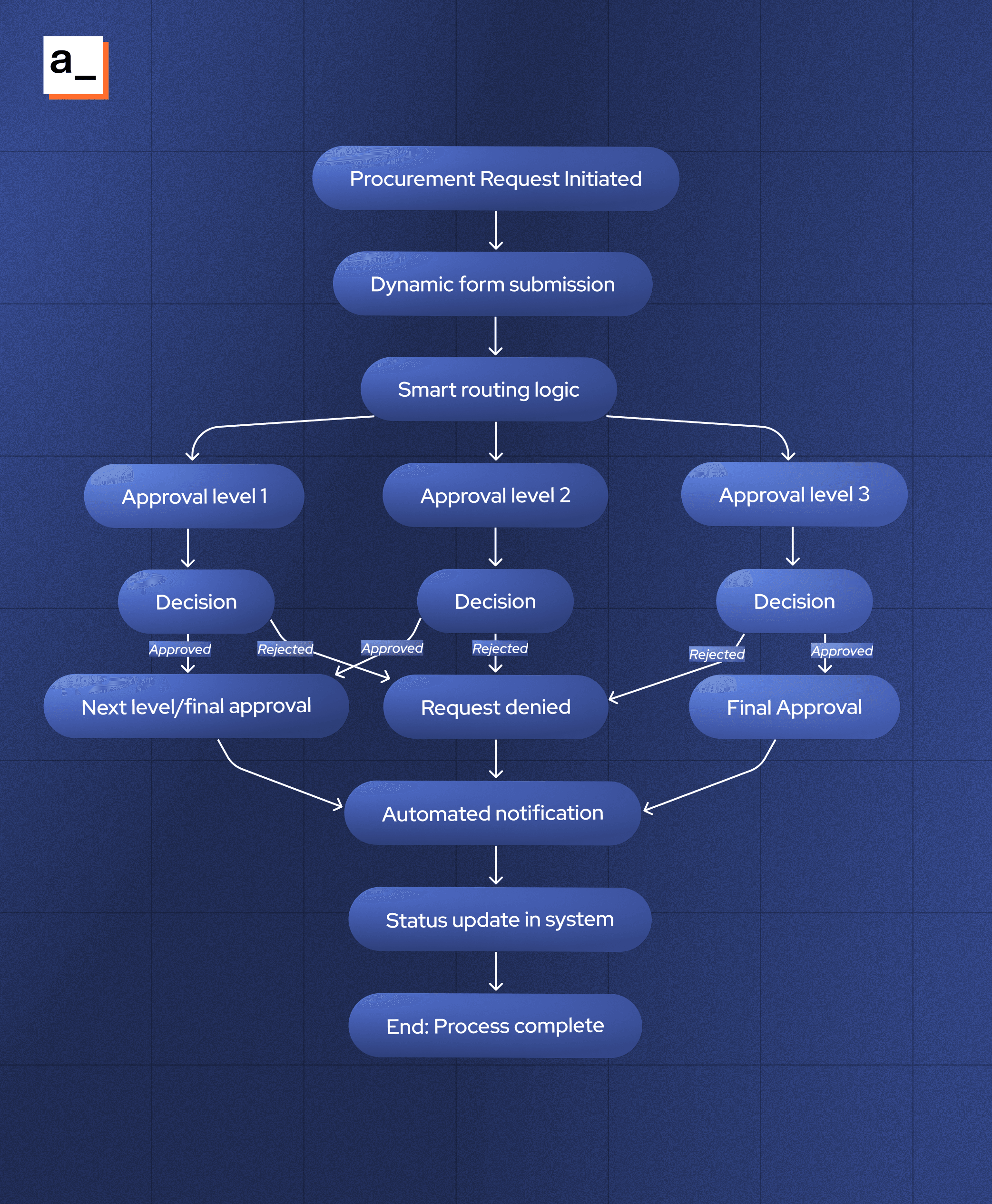Streamline Procurement Approvals with Low-Code Workflow Automation

Businesses must consider numerous factors to grow effectively over time. Streamlining critical processes like procurement approvals can significantly enhance operational effectiveness.
This article explores how low-code automation, specifically using Appsmith Workflows, can help developers transform the procurement approval process, making it faster, more transparent, and less error-prone for businesses.
Why automate processes with low-code?
Low-code automation tools have gained traction in recent years, offering businesses a way to optimize their operations without the complex development burden.
These tools reduce development time, lower the long-term cost of ownership, and simplify the implementation of business logic compared to writing boilerplate code. They offer several key advantages:
Rapid development: Low-code tools enable quick building and deployment of automated workflows in a fraction of the time compared to building from scratch.
Flexibility: Every business is unique, and your automation should reflect that. Low-code platforms can be easily customized to fit specific business needs and processes, especially when they allow for adding custom code.
Integration capabilities: Your tools need to communicate with each other. Low-code developer-centered solutions come with built-in integrations for existing systems or through REST/GraphQL APIs.
Reduced technical debt: With less custom code to maintain, the long-term cost of ownership is lower.
Low-code automation offers a way to quickly implement solutions that would otherwise require significant time and resources to build from scratch. While traditional development might involve months of work and a team of skilled developers to automate processes, low-code platforms can dramatically reduce this timeline and complexity.
The procurement predicament: when manual becomes a maze
In many organizations, getting approval for a purchase can feel like navigating a labyrinth blindfolded, as it often involves complex multi-level processes with numerous stakeholders.
A typical procurement request might go through multiple stages of review and approval—from initial submission to endorsements by managers, department heads, and senior executives before receiving final approval. Managing these stages manually or using disparate systems leads to inefficiencies, delays, and communication breakdowns.
Some common issues include:
Lack of visibility into the current status of requests
Delays caused by manual routing and communication
Over-reliance on emails for notifications and updates
Difficulty tracking approvals, leading to bottlenecks
These challenges not only slow down the procurement process but can also lead to missed opportunities, increased costs, and frustrated employees. A centralized, automated solution is needed to address these challenges effectively.
Automate procurement approvals with low-code automation using Appsmith workflows

Appsmith is an open-source low-code platform designed for building internal tools and automating business processes. It offers a powerful solution for creating custom applications and workflows without extensive coding.
We recently introduced the feature workflows, which provides an efficient way to manage and automate the entire procurement approval process in your business. Here's how Appsmith workflows addresses key pain points in the procurement process:
Centralized workflow management: Appsmith allows all stages of the procurement process—from submission to final approval—to be managed by one workflow. The workflow automatically routes requests based on predefined rules such as approval amounts, department hierarchies, and user roles, ensuring the right stakeholders are notified at each stage. This centralization eliminates the need for manual handoffs and reduces the chance of requests getting lost in the system.
Automated notifications and status tracking: Instead of relying on manual emails, the workflow sends automatic notifications when a status changes, whether it's a submission awaiting review or an endorsement pending approval. Stakeholders are promptly notified based on predefined triggers, reducing communication delays. This ensures that all parties involved are always aware of the current status of a request, improving transparency and reducing follow-up inquiries.
Dynamic forms and configurations: The workflow adapts to user needs, allowing input of relevant data—such as service types and supplier details—through searchable and filterable dropdown menus. This streamlines form submissions, minimizes errors, and speeds up the overall process. Forms can be easily updated to reflect changes in the procurement process without extensive recoding. Appsmith allows building a UI that captures request information and inputs necessary data for subsequent steps.
Smart routing logic: Based on factors like request amounts and department structures, the workflow automatically determines the correct approval path. This logic ensures compliance while minimizing manual intervention and decision-making delays. It also allows for easy implementation of complex approval hierarchies that might be difficult to manage manually.
Flexible options for procurement teams: In cases where the procurement team initiates the request, the workflow allows them to input necessary data upfront and skip steps that don't apply, ensuring the process remains efficient. This flexibility accommodates various scenarios and user roles within the procurement process, making the system adaptable to different organizational structures.

Here's an example illustrating the key automated steps of procurement approvals using Appsmith workflows:
Dynamic form submission for initiating requests
Smart routing logic based on predefined rules (e.g., approval amounts, department hierarchies)
Multiple approval levels with automated routing
Automated notifications at each stage of the process
Real-time status updates in the system
This automated workflow centralizes the entire process, reduces manual interventions, and ensures transparency throughout the procurement approval cycle.
How can your tech team benefit from Appsmith low-code automation for procurement approvals?
Appsmith workflows offers a developer-focused platform that can significantly improve your tech team's ability to automate complex business processes. Among the key benefits are:
Rapid development: Combines code-based and node-based systems for faster workflow creation, allowing developers to focus on logic and functionality rather than tedious configurations.
Flexibility and customization: Incorporates complex logic through JavaScript, allowing your team to tailor the procurement approval process to your organization's specific needs and requirements.
Seamless integrations: Easily connects with existing databases, making it simpler for your tech team to integrate with existing databases, ERPs, or other internal tools.
Human-in-the-Loop capabilities: Allows your team to build workflows that seamlessly incorporate human decision-making when necessary, ensuring compliance and maintaining control over critical approvals.
Using Appsmith workflows, your tech team can streamline the development of procurement approval systems, saving time and resources while allowing your developers to focus on strategic initiatives—all while delivering robust, scalable, and customized automation solutions for your organization.
Low-code automation vs. manual processes
While smaller businesses often find it easier to manage procurement approvals manually, this approach doesn't scale well as the company grows. Even for small businesses, developers should anticipate how manual processes can become problematic over time.
Implementing low-code automation early on provides a quick and easier path to ensure these processes can scale effectively as the business expands. Here are the benefits of low-code automation compared to manual processes:
Aspect | Manual process | Low-code automation |
Speed | Slow, time-consuming | Significantly faster processing times |
Accuracy | Prone to human errors | Minimized errors due to reduced manual data entry |
Consistency | Varies based on individual handling | Consistent approval paths for all requests |
Visibility | Limited, often unclear status | Real-time access to request status |
Scalability | Difficult to scale efficiently | Easily handles increased volume without proportional resource increase |
Cost-Efficiency | Higher long-term costs | Initial investment, but long-term savings in time and resources |
The shift from manual to automated processes can be transformative, freeing up resources to focus on strategic initiatives rather than administrative tasks.
Get started streamlining procurement approvals
As businesses continue to seek ways to optimize their operations, low-code automation stands out as a flexible, scalable, and cost-effective solution for optimizing business operations.
Get started to speed up the development process and reduce the long-term maintenance burden.
Automate complex, human in the loop processes
Try Appsmith's new workflow features in public beta. Build secure automated processes with streamlined integrations and code-first controls.



